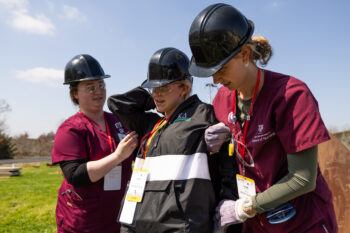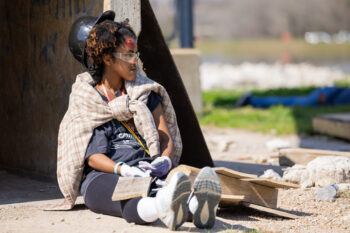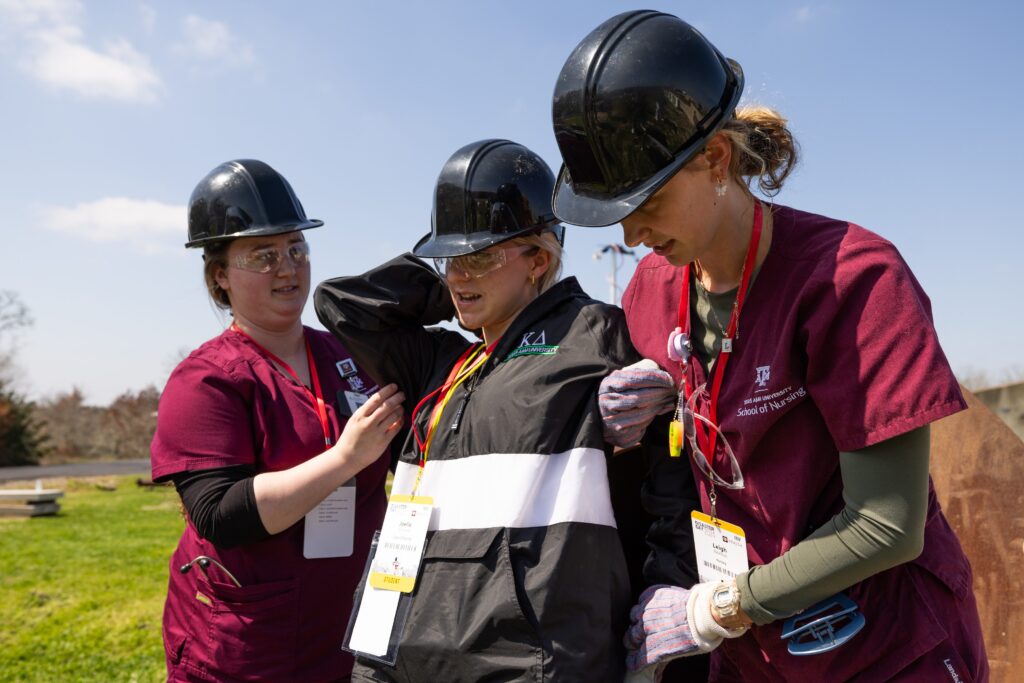
Texas A&M Health Science Center and Texas A&M Engineering Extension Service (TEEX) hosted a 2024 Disaster Day simulation in Disaster City on Friday, March 1, 2024.
Cameron Johnson / Texas A&M University Marketing and Communications Department
Texas A&M University students on Friday survived the chaos of tropical storm flooding, earthquakes and gunfire in a mock disaster designed to prepare future health care workers for large-scale emergencies.
The student-led exercise was held at the Texas A&M Engineering Extension Service (TEEX) Disaster City in College Station and tested students in a variety of areas including triage, patient care, mental health support, and disaster management.
Initiated by the Texas A&M School of Nursing in 2008, the training grew from a small event held in a local church gymnasium to over 700 students, 100 faculty members, and dozens of emergency response professionals. It has grown into a day-long disaster simulation. Texas A&M School of Dentistry, Medicine, Nursing, Pharmacy and Public Health students, athletic training, psychology and veterinary medicine students, and the Corps of Cadets participated in the training.
Kristin Kaunas, assistant vice president for Interprofessional Practice, Education, and Research (IPER) at Texas A&M Health Science Center, said the annual disaster day exercise is an important element in preparing students to collaborate in an emergency situation. He said that there is.
“Since 2020 alone, Texas has experienced more than 15 disasters and related declarations, including wildfires, tropical storms, hurricanes, winter storms, and, of course, COVID-19. It is important that students are equipped to respond effectively to disasters at any time, not just when they occur,” Kaunas said.
More than 50 students from Texas A&M Health are working to plan and host this event with the supervision of faculty and staff from TEEX, the Texas State Emergency Management Agency, and participating partners.

A Texas A&M University student plays the role of a victim during a 2024 Disaster Day training simulation in Disaster City on Friday, March 1, 2024.
Cameron Johnson / Texas A&M University Marketing and Communications Department
Each year, a new scenario is selected and kept secret until the day of the event, providing a sense of realism of the unexpected. This year's simulated disasters included a tropical storm, flood, earthquake and an active gunfight. Students will be involved in triage at disaster sites, patient care in mock field hospitals, mental health care and needs assessment in evacuation centers and family reunification centers, and disaster management and simulation monitoring in disaster city emergency operations training centers. I was engaged.
During the simulation, students assume the role of a patient or health care provider or participate in search and rescue. Students participating as patients undergo a make-up called “Mulage'' that mimics an injury based on a scenario. Patients act out their assigned cases, and students play the roles of doctors and nurses to conduct on-site assessments and then transport patients to field hospitals for further diagnosis and treatment. Pharmacy students work with medical professionals to determine what medications are needed, and psychology students provide necessary mental health care to survivors. Athletic Training and Dentistry students provide specialized care in orthopedics and soft tissue trauma, and head and neck trauma, respectively. Public health students manage disasters, deploy resources, and respond to outbreaks. Veterinary students are caring for the affected animals.
Dr. Angela Clendenin, an associate professor of education at Texas A&M Health who specializes in epidemiology and biostatistics, said the exercise includes all the elements of a real-life emergency and involves different people working together to solve a problem. He said it was effective because of cooperation.
“It shows you exactly what can happen in a community and gives you soft skills like cross-disciplinary communication, teamwork, leadership and collaboration, but at the same time gives you confidence in case something happens. “I think it gives them 'the community where they end up practicing, they get that muscle memory,'” she said.
First-year nursing student Alison Rieux said she was interested in playing the role of an injured person and seeing how other students diagnose and treat their injuries.
“This is exactly what you learn in nursing school: how to assess symptoms and create a treatment plan based on symptoms,” she said.
Other students said the exercise helped them connect their classroom experience with real-life challenges in their profession.
“It's really interesting to see what I learned in the crisis management class put into practice. This is the first hands-on experience I've really had,” said Olivia Bomba '26, a public health major. said.
“Disaster Day serves as a great learning opportunity for students, balancing the disruption of an emergency with the structure and support needed for successful and meaningful learning,” said a graduate student majoring in environmental health at a public graduate school. , said Lissa Rosa. Director of Health Planning on Disaster Day.
As the event has grown, so have our collaborations with businesses and government agencies, including HEB, the Salvation Army, St. Joseph Health, Pulcella, and the Texas Emergency Management Agency. Members of the university community, private and public partners, and representatives from local, state and federal agencies toured this year's event and learned about Texas A&M Health's efforts in disaster response.
“Disaster Day is a testament to Texas A&M Health's proactive commitment to developing agile and resilient Aggie medical professionals,” said Indra Reddy, Chief Operating Officer and Vice President, Texas A&M Health. ”. “With the frequency of large-scale emergencies increasing, we are proud that Aggie medical professionals remain well-prepared and ready to respond.”

Texas A&M Health Science Center and Texas A&M Engineering Extension Service (TEEX) hosted a 2024 Disaster Day simulation in Disaster City on Friday, March 1, 2024.
Cameron Johnson / Texas A&M University Marketing and Communications Department


